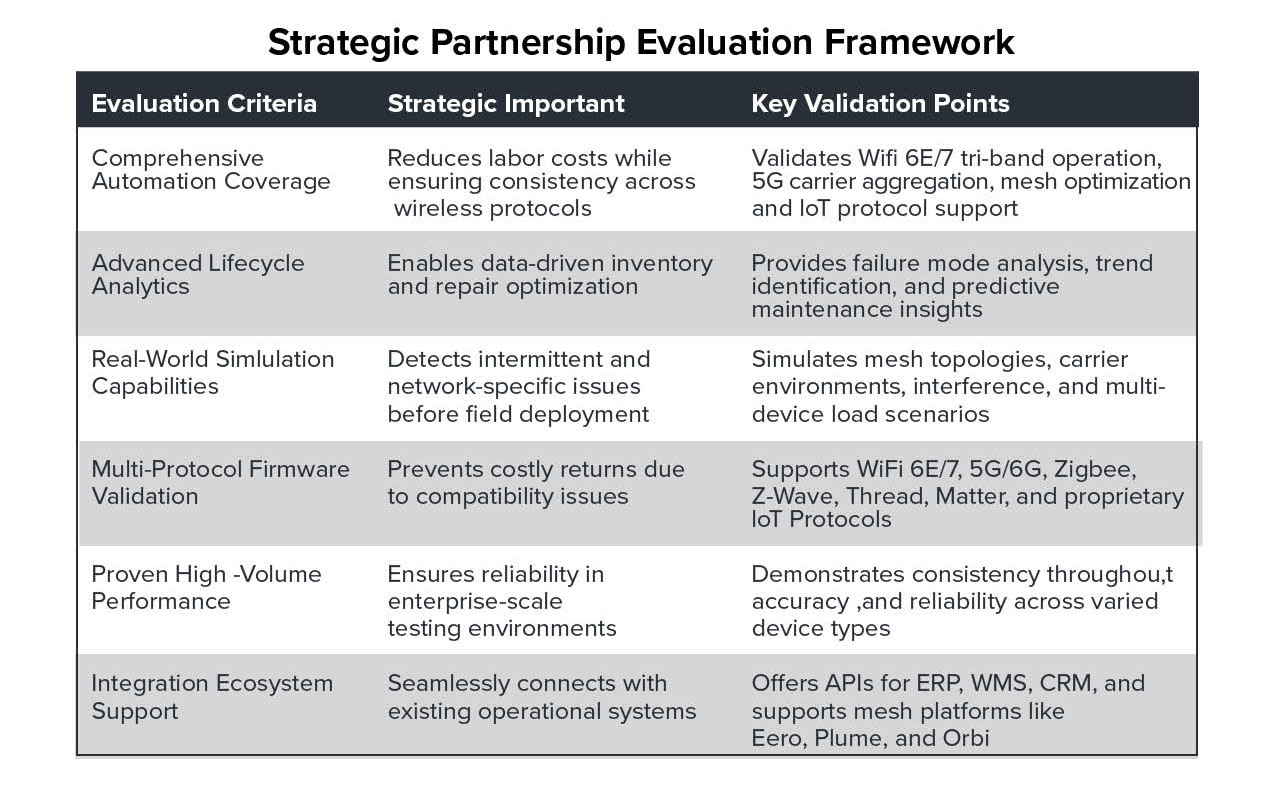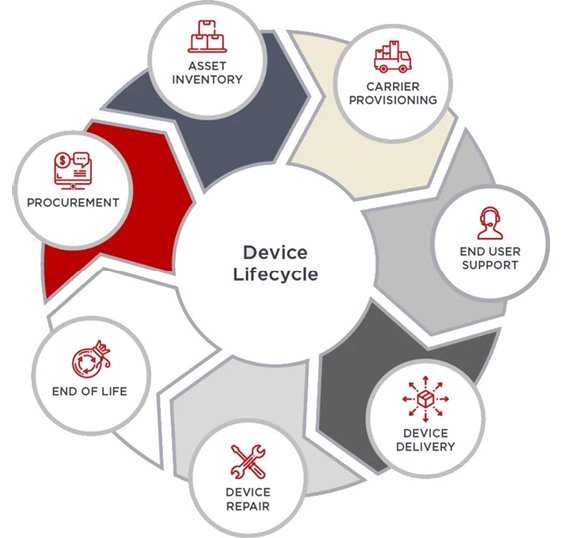A Lifecycle-Driven Approach to Device Recovery and Inventory Resilience
In today’s hyper-connected ecosystem, testing has evolved from a basic quality assurance task into a strategic lever that affects operational costs, device longevity, and inventory readiness. As connected products grow more complex—spanning wireless protocols, multiple frequency bands, and mesh topologies—manual testing is no longer sufficient for scale or precision.
Modern automated testing provides more than pass/fail validation. These systems simulate real-world conditions across 2.4, 5.0, 6.0, and 7.0 GHz bands; verify firmware compatibility across various hardware types; detect elusive intermittent faults; and generate diagnostic data to guide decisions.
Integrating automation into reverse logistics and refurbishment enables organizations to increase operational efficiency and recover value from devices that might otherwise become e-waste.
This analysis explores how automated testing transforms supply chain performance, focusing on wireless technologies and mesh networks. We highlight quantifiable value drivers, resilience benefits amid tariff volatility, and real-world case studies where automation saves millions while enhancing sustainability.
The Hidden Cost of Inefficient Testing
Many device recovery workflows still depend on manual testing led by technician intuition rather than standardized diagnostics. While manageable at low volume, this method quickly falters at scale:
- Recoverable high-value devices are unnecessarily scrapped due to incomplete diagnostics
- Return rates remain elevated because insufficient testing misses intermittent connectivity issues
- Support teams are overwhelmed with preventable service calls related to WiFi 6E compatibility, mesh node pairing failures, and band steering problems
- New inventory procurement accelerates to replace units that could have been successfully refurbished and redeployed
- Firmware incompatibilities go undetected, leading to field failures across mesh networks and 5G/6G gateway deployments
These inefficiencies cascade across repair, fulfillment, support, and customer experience. Automating testing is often the most cost-effective way to strengthen the entire lifecycle.
Why Automation Matters Now
As connected devices evolve to support WiFi 6E/7, 5G/6G cellular technologies, and sophisticated mesh networking architectures, the complexity of comprehensive testing has grown exponentially. Modern devices must seamlessly operate across multiple frequency bands (2.4 GHz, 5.0 GHz, 6.0 GHz, and emerging 7.0 GHz), support diverse mesh topologies, and maintain compatibility with an ever-expanding ecosystem of networking protocols.
Manual methods can't meet the speed, accuracy, or volume requirements for:
- Tri-band WiFi 6E/7 validation
- Full mesh topology and backhaul testing
- Carrier-specific provisioning for 5G/6G gateways
- IoT cloud integration and OTA updates
IoT devices with complex cloud integration and OTA update requirements
Automated test systems address these needs by:
- Simulating real-world network conditions and load
- Verifying firmware, performance, and system integration
- Generating real-time data for trend analysis and defect mapping
- Automating triage for redeployment, repair, or recycling
This shift improves recovery rates, reduces returns, and stabilizes inventory in dynamic environments.
Where Automation Delivers the Most Impact
WiFi Mesh Networks
Modern mesh systems have become the backbone of seamless connectivity, but their sophisticated distributed architecture introduces unprecedented testing complexity. Today's leading mesh solutions—including Amazon Eero Pro 6E/7, Plume SuperPods, Netgear Orbi WiFi 6E/7 series, ASUS AiMesh AX6000/AX11000, TP-Link Deco X95/XE200, and Linksys Velop AX4200/AX5300 and many more —must not only function flawlessly as individual nodes but also coordinate seamlessly across multiple frequency bands and dynamic network topologies.
Manual validation often fails to detect pairing issues, signal degradation, or suboptimal band allocation—all which impact user experience. Automated testing systems address this by:
- Simulating full mesh topologies, validating how devices connect, relay data, and respond to changes in topology
- Verifying band steering, ensuring devices can automatically transition between 2.4 GHz, 5 GHz and other channels based on signal strength and congestion
- Ensuring firmware alignment across nodes, a critical factor in maintaining mesh stability and update compatibility
- Testing backhaul and front-haul communication, capturing how efficiently nodes route traffic and self-heal during dropouts
This end-to-end automation prevents misdiagnosis in the field and allows high-confidence redeployment after refurbishment.
Advanced 5G/6G Fixed Wireless Access (FWA) Gateways
FWA devices represent some of the most complex wireless equipment in deployment today, serving as critical bridges between advanced cellular infrastructure and sophisticated home/business networks. These devices must seamlessly integrate 5G/6G cellular technologies with WiFi 6E/7 distribution, making them sensitive to both carrier-specific provisioning requirements and complex in-premises networking demands.
Advance SIM provisioning and activation, confirming the device can securely authenticate with the correct carrier network
- Signal acquisition and lock, across multiple frequency bands and technologies (e.g., 4G fallback, mmWave support)
- Speed and latency performance, simulating network load and environmental interference
- Band prioritization logic, especially in carrier-aggregated environments
Automated test benches replicate carrier environments, allowing devices to be tested under simulated load conditions before redeployment.

IoT and Smart Devices
Though often smaller and simpler in form, IoT devices bring their own testing challenges. They typically operate in constrained environments, rely on intermittent connectivity, and are highly firmware dependent.
Automation helps by:
- Verifying cold boot behavior and startup sequences, which are common failure points in returns
- Calibrating onboard sensors and interfaces, such as motion detectors, thermostats, or smart buttons
Validating cloud provisioning and handshake protocols, ensuring that devices can register and communicate securely after reset
- Running OTA (over-the-air) firmware validation, confirming that updates apply correctly and preserve device settings
These steps are difficult and time-consuming to execute manually. By automating them, teams can process high volumes of returned or refurbished units quickly—while reducing human error and boosting device reliability post-deployment.
How Automated Testing Supports Broader Business Goals
In today’s competitive environment, testing has evolved from a backroom technical task into a strategic business capability. Organizations that integrate automated testing into their supply chain and reverse logistics operations not only improve device quality but also realize value across sustainability, customer experience, finance, and product innovation.
Sustainability:
- Automated testing keeps functional hardware in circulation, reducing landfill and the need for new production. This supports ESG goals and reduces resource use.
Customer Experience:
- Thorough automated testing ensures fewer DOA units, lower return rates, and improved out-of-box experience—resulting in higher CSAT and fewer support calls.
Financial Efficiency:
- Automated systems reduce testing labor costs and increase device recovery. This delays procurement and lowers cost per deployed unit—a key advantage during tariff uncertainty.
Data Intelligence:
- ·Every automated test produces structured data. Trends in failure types, firmware behavior, or part wear enable smarter inventory, warranty, and design decisions.
As devices and supply chains grow more complex, organizations that treat testing as a strategic asset will be better positioned to compete, adapt, and lead.

Lifecycle Economics in Action
A North American broadband provider integrated automated testing into supply chain returns program.
In the first year alone:
- 150k+ devices recertified
- $8.2 M+ in avoided hardware replacement costs
- 36% drop in return rates
- 50% reduction in repair timelines
They also surfaced root-cause issues like firmware mismatches that manual testing had missed.
Key Takeaways from the Field
Over the past decade, organizations across telecom, consumer electronics, and IoT have implemented automated testing within their refurbishment and reverse logistics workflows. Their experiences reveal several core principles that extend far beyond quality assurance—showing how testing directly contributes to smarter, more resilient supply chains.

Data Closes the Loop
One of the most transformative aspects of automation is the visibility it creates. Every device tested generates structured data—capturing pass/fail results, error codes, and performance metrics. When collected at scale, this diagnostic data can be analyzed to uncover trends and root causes that are otherwise invisible in manual operations.
- Helps identify common failure patterns by SKU, batch, or firmware version
- Enables evidence-based product updates or design changes
- Supports warranty validation with clear test documentation
- Improves decision-making across engineering, support, and supply chain teams
In the past, a failed device might have been logged generically as "non-functional." With automation, stakeholders gain detailed insight into why it failed—and how often similar failures occur across the product line.
Consistency Lowers Cost
Automated testing enforces standardized workflows, ensuring that every unit undergoes the same set of validations—regardless of location, technician, or product type. This eliminates the variability and subjectivity inherent in manual QA processes, which can lead to false passes, undetected faults, or unnecessary rework.
- Improves quality control across multiple facilities or vendors
- Increases confidence in test outcomes for redeployed units
- Reduces the cost of retesting, re-handling, and customer returns
- ·Streamlines training and operational oversight
Standardization is especially critical when working with outsourced fulfillment or third-party repair centers. Automated testing ensures that every partner follows the same technical and quality standards without needing to scale headcount or retrain staff.
"OEMs are no longer asking if a device powers on—
they want to know if it pairs seamlessly, auto-updates,
recovers from errors, and delivers the expected user
experience in multi-device environments.
Testing must evolve to answer those questions automatically."
— Chief Technology Officer, Contec
Redeployment Speed Drives ROI
Every day a returned device sits untested is a day of lost opportunity. The longer the delay in triaging and certifying assets for redeployment, the more organizations rely on new inventory—which may be subject to tariffs, sourcing delays, or price volatility.
Automated systems dramatically accelerate this timeline, allowing companies to extract more value from what they already own.
- Cuts processing time from days to hours
- Allows for real-time redeployment into fulfillment workflows
- ·Supports leaner inventory strategies by closing the return-to-stock loop faster
- Reduces pressure on procurement during supply chain disruptions
Redeployment is not just a technical milestone—it’s a financial one. The faster a device re-enters service, the lower the cost per use cycle and the higher the return on the original investment.
Conclusion: From Cost Center to Strategic Enabler
As supply chain volatility increases—from fluctuating tariffs to hardware shortages—organizations are rethinking how they manage, recover, and redeploy their connected tech assets. Throughout this article, test automation experts have highlighted how automated diagnostics, standardization, and real-time data are transforming what testing can do—not just for devices, but for entire operations.
We’ve seen that:
- Data closes the loop, turning test logs into actionable insight for engineering, support, and inventory planning
- Consistency lowers cost, enabling faster, higher-confidence disposition decisions
- Redeployment speed drives ROI, reducing dependence on uncertain hardware pipelines
- Lifecycle strategies, supported by testing automation, help companies shift from costly procurement cycles to sustainable reuse models
- And in today’s tariff-heavy climate, maximizing the value of what you already own is not just efficient—it’s essential
Testing is no longer a background task—it’s a business-critical capability. In the race to stay competitive, automation isn’t optional. It’s foundational.
Brett Gorchov is the Senior Director of Customer Success at Contec, a 4PL leader specializing in forward and reverse logistics for connected technology. His passion for customer success is rooted in his early career as a sales trainer with HBO and Showtime, and later as a sales training leader at Time Warner Cable, where he developed and delivered programs that empowered frontline teams and strengthened customer engagement. These formative experiences laid the groundwork for a successful career guiding complex service operations, driving retention strategies, and leading customer-centric initiatives. At Contec, Brett leads initiatives that extend product lifecycles, reduce operational costs, and transform logistics into a competitive advantage for some of the world's top connected tech brands.